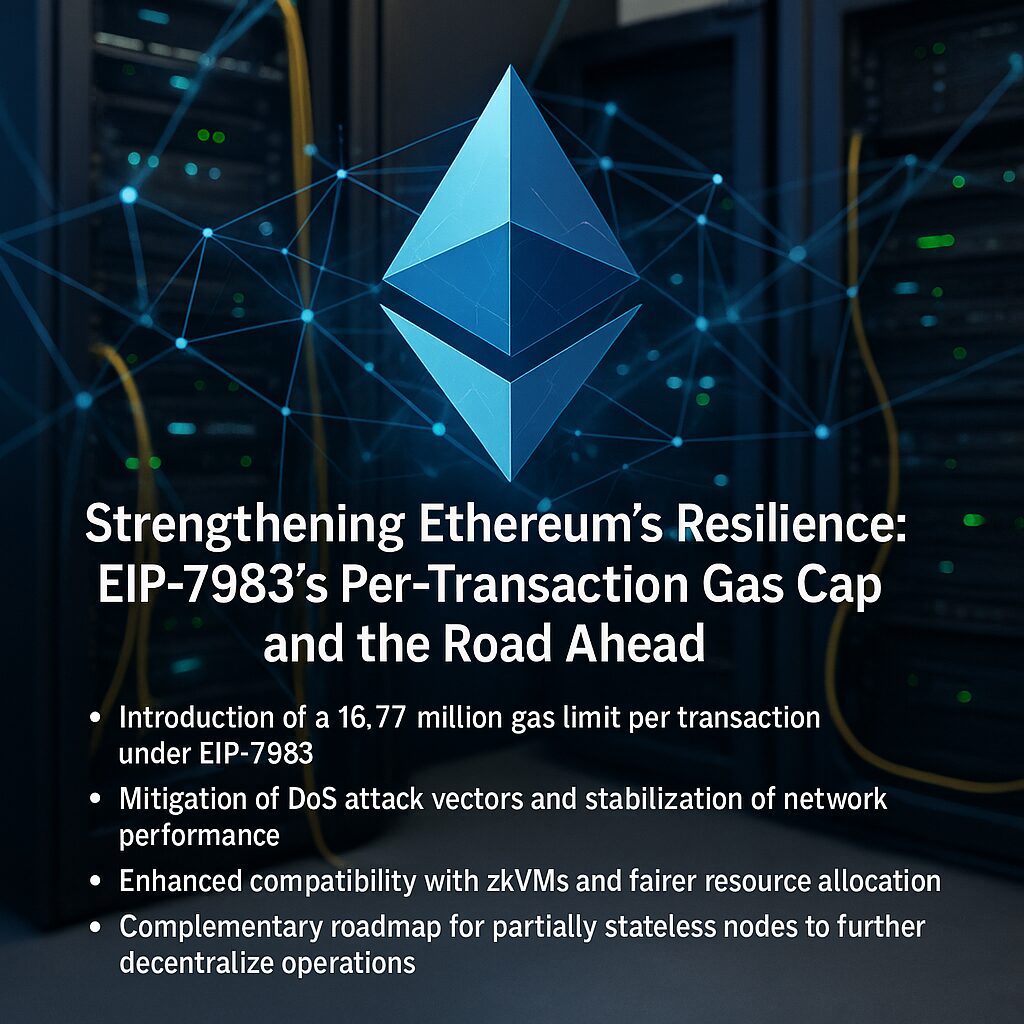
Main Points:
- Introduction of a 16.77 million gas limit per transaction under EIP-7983
- Mitigation of DoS attack vectors and stabilization of network performance
- Enhanced compatibility with zkVMs and fairer resource allocation
- Complementary roadmap for partially stateless nodes to further decentralize operations
- Broader scaling context: Proto-Danksharding (EIP-4844) and layer-2 optimizations
Background: The Case for a Protocol-Level Gas Cap
Ethereum’s flexibility has enabled a vast range of decentralized applications (dApps) and DeFi protocols, but it has also introduced vulnerabilities: in the current architecture, a single transaction can theoretically consume an entire block’s gas limit (32 million), opening the door for service-disrupting attacks and unpredictable transaction costs. To address these concerns, Ethereum co-founder Vitalik Buterin and researcher Toni Wahrstätter jointly proposed EIP-7983, which mandates a per-transaction gas ceiling of 16.77 million units (2²⁴) at the protocol level. By doing so, Ethereum aims to bolster its defense against certain denial-of-service (DoS) vectors and improve the predictability of gas consumption for users and node operators alike.
Tackling DoS: Predictable Resource Allocation
Denial of Service (DoS) attacks seek to overwhelm network nodes by submitting high-gas transactions that monopolize block capacity and induce delays or failures in block propagation. EIP-7983’s cap ensures that no single transaction can exceed 16.77 million gas, limiting the maximum “blast radius” of any malicious submission. Transactions exceeding this limit will be invalidated both in the transaction pool and during block validation, effectively filtering out potential attack vectors early in the process.
Enhancing Network Stability and zkVM Compatibility
By preventing outlier transactions from consuming excessive resources, EIP-7983 helps to smooth block validation times and reduce variability in node workload. This stability is particularly crucial as Ethereum embraces new execution paradigms, such as zero-knowledge virtual machines (zkVMs), which often break large computations into multiple sub-proofs. A standardized gas ceiling underpins more predictable execution paths, making it easier for zkVMs and other parallel-execution systems to integrate seamlessly with Ethereum’s base layer.
Fairness in Resource Distribution
When gas-heavy transactions are split into smaller, capped units, network participants experience more equitable treatment. Capping per-transaction gas not only prevents “gas hogs” but also encourages developers to design contracts that operate within predictable execution envelopes, thus promoting smarter gas management and reducing sudden spikes in network demand. This change fosters a fairer marketplace where all transactions, from simple transfers to complex DeFi interactions, abide by the same upper limit.
EIP-7983 in Practice: Impact on Users and dApps
Most existing Ethereum transactions consume well below the proposed 16.77 million gas threshold, meaning the vast majority of users and dApps will see no change to normal operations. Complex DeFi protocols or NFT minting contracts that rely on unusually high gas consumption may need to refactor logic or split operations across multiple transactions. Overall, impact is expected to be minimal for typical use cases, while delivering outsized benefits in security and performance predictability.
Broader Scaling Landscape: Proto-Danksharding (EIP-4844)
EIP-7983 arrives amid a flurry of scaling efforts on Ethereum’s roadmap. One notable development is Proto-Danksharding (EIP-4844), which introduces “blob-carrying” transactions to reduce data availability costs for layer-2 rollups by 10–100×. Blobs are large, ephemeral data chunks stored on Ethereum’s consensus layer, enabling rollups like Optimism and zkSync to batch transactions off-chain more cost-effectively. Together, EIP-7983’s gas cap and EIP-4844’s blob transactions compose a complementary strategy: one ensures per-transaction fairness, the other slashes data costs and boost throughput.
Advancing Decentralization: Partially Stateless Nodes
In May 2025, Vitalik Buterin outlined a “partially stateless node” concept, designed to let node operators verify blocks without storing the entire Ethereum state. These nodes maintain only a chosen subset of chain data—such as active wallets or frequently accessed contracts—while relying on off-chain data for the rest. This model promises to lower hardware requirements by up to 10–100×, making node operation accessible to everyday users and enhancing Ethereum’s decentralization and censorship resistance.
Future Outlook: Synergies and Next Steps
EIP-7983, Proto-Danksharding, and partially stateless nodes are pivotal parts of Ethereum’s scaling and security blueprint. With EIP-7983 reducing the risk of transaction-level overloads, EIP-4844 boosting layer-2 throughput, and novel node designs lowering the barrier for participation, Ethereum is charting a path toward a more resilient, scalable, and decentralized future. As these proposals progress through the Ethereum Improvement Proposal (EIP) process, developers and node operators should prepare by reviewing contract logic for gas efficiency, upgrading clients for blob support, and exploring stateless node frameworks.
Conclusion
EIP-7983’s introduction of a 16.77 million gas cap per transaction represents a significant milestone in Ethereum’s maturation, addressing key vulnerabilities and operational uncertainties. By imposing a predictable ceiling on per-transaction resource consumption, this proposal strengthens defenses against DoS attacks, enhances network stability, and aligns with broader scaling efforts like Proto-Danksharding and partially stateless nodes. For builders and investors seeking the next wave of blockchain innovation and revenue opportunities, these developments underscore Ethereum’s commitment to robust security, efficient performance, and inclusive decentralization.

